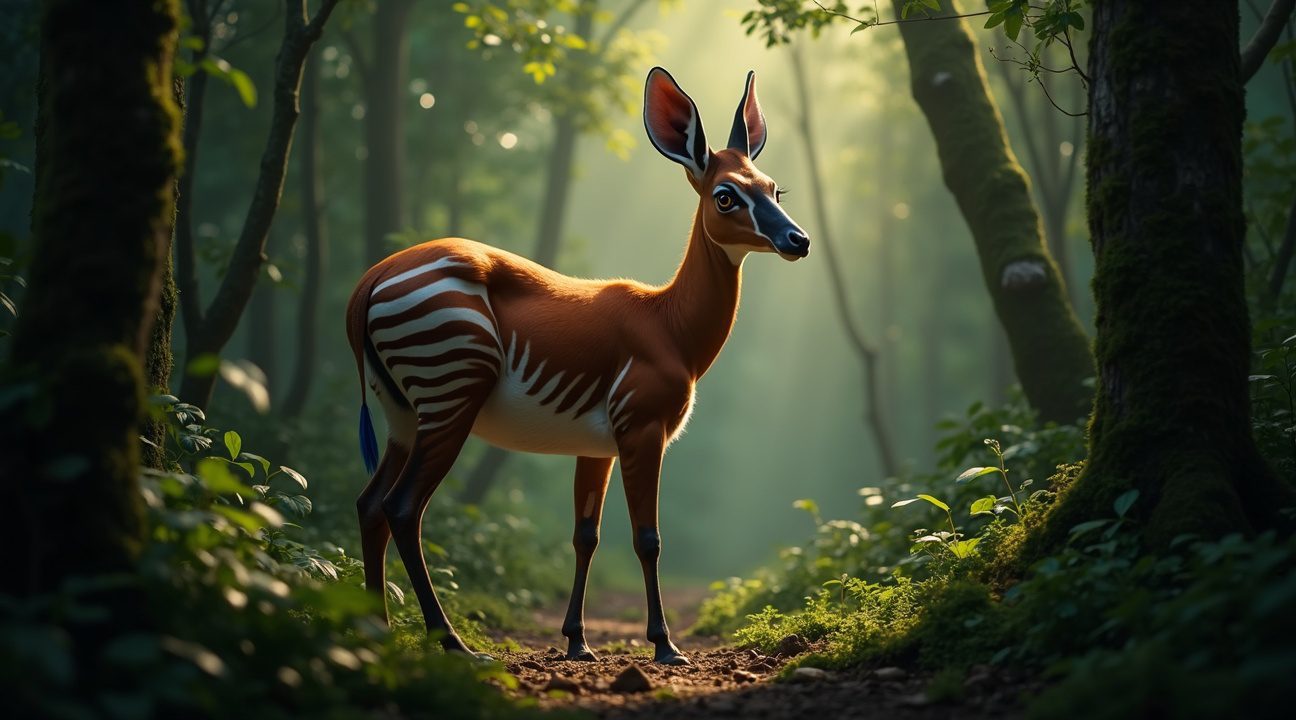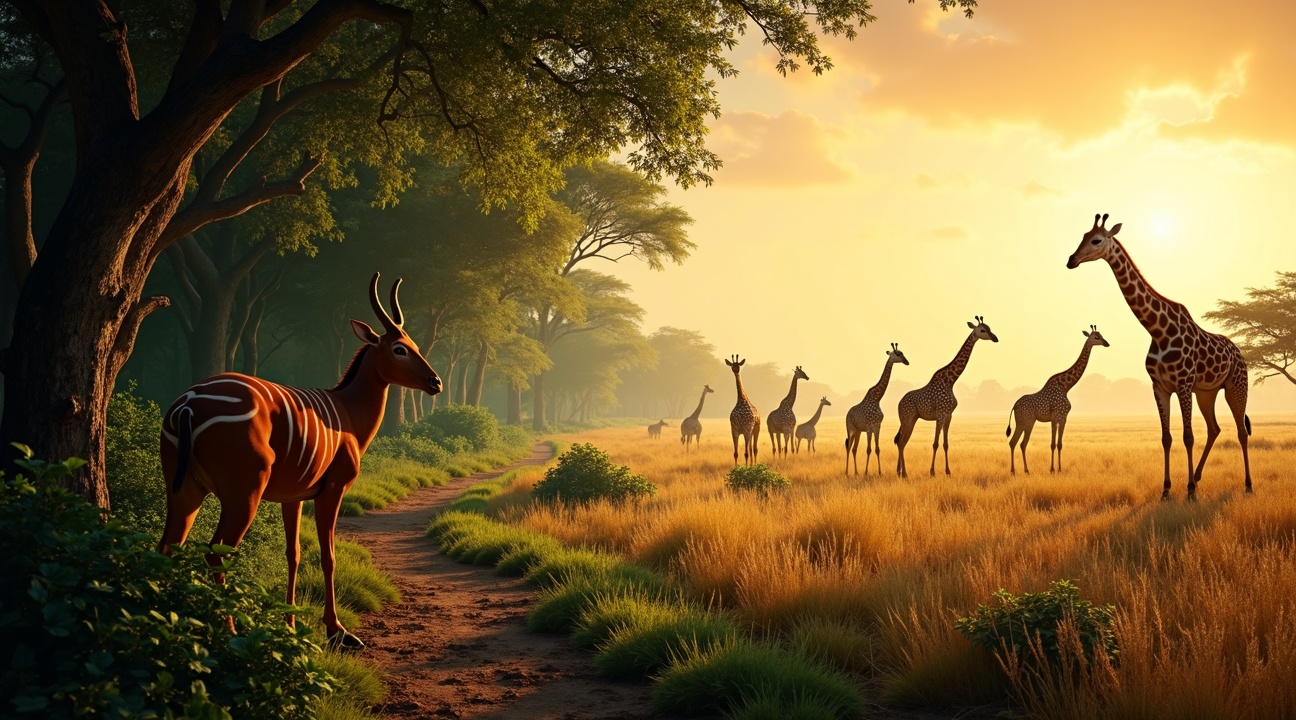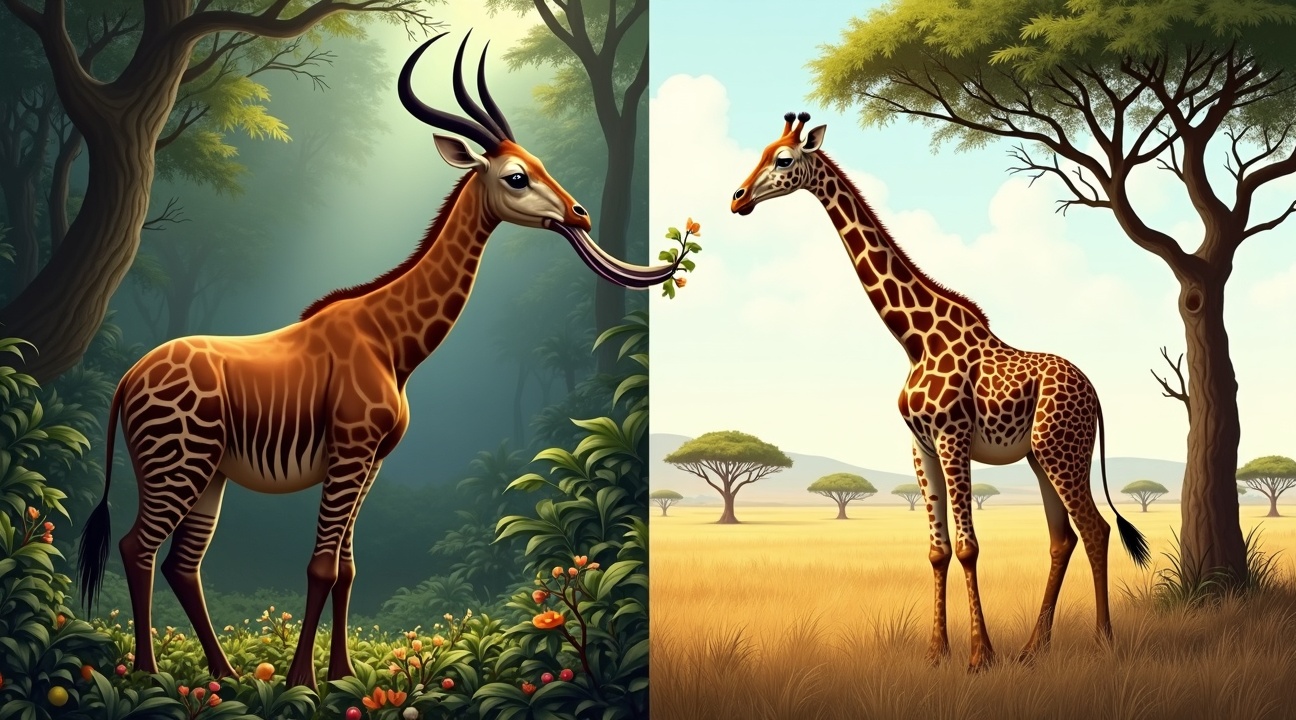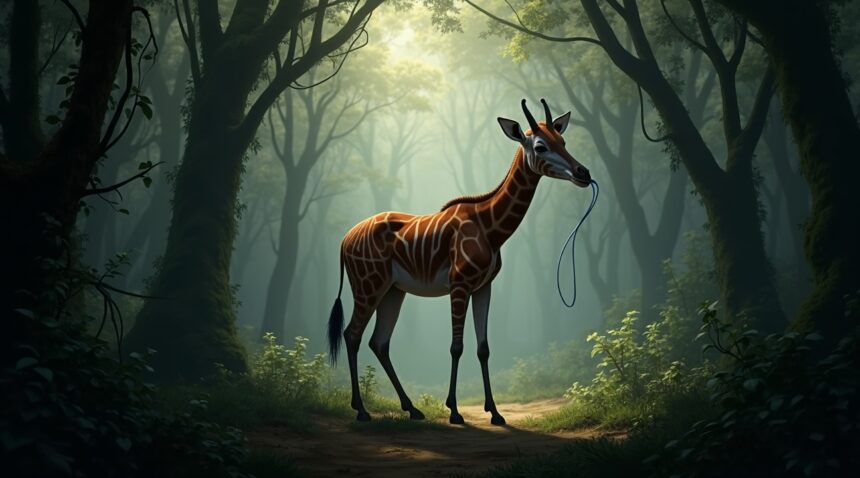Okapis represent the giraffe’s sole surviving relatives, sharing remarkable adaptations like 18-inch prehensile tongues that can lick their own ears and similar browsing behaviors despite their vastly different habitats.
Giraffes tower across African savannas, while okapis have remained hidden in Congo’s dense rainforests for millions of years. These secretive forest dwellers evolved distinctive zebra-like striped rumps and compact builds perfectly suited to maneuvering through thick vegetation.
Key Takeaways
- Okapis and giraffes diverged from a common ancestor 11–12 million years ago, with 19.4% of their proteins remaining identical despite separate evolutionary paths.
- Both species possess extraordinary tongues extending up to 18 inches, specialized digestive systems as ruminants, and similar 15-month gestation periods reflecting their shared genetic heritage.
- Okapis live exclusively in the Democratic Republic of Congo’s rainforests with an estimated population of 30,000, while giraffes spread across multiple African countries in open savannas.
- Genetic analysis reveals that giraffes developed unique mutations in HOX, NOTCH, and FGF gene pathways to achieve extreme height, while okapis retained forest-adapted proportions.
- Okapis face vulnerable conservation status due to habitat destruction, bushmeat trade, and political instability, making them significantly more endangered than their savanna-dwelling relatives.
To learn more about conservation efforts related to okapis, visit the Okapi Conservation Project.
The Mysterious Forest Dweller That Can Lick Its Own Ears
I find it fascinating that okapis possess one of nature’s most remarkable abilities — they can actually lick their own ears. This extraordinary feat stems from their incredibly long, prehensile tongue that can extend up to 18 inches in length. The bluish-colored appendage serves the same primary function as their giraffe cousins’ tongues, allowing them to strip leaves from high branches with precision and efficiency.
Shared Traits with Their Giraffe Relatives
Beyond the impressive ear-licking capability, okapis and giraffes share several distinctive characteristics that highlight their close evolutionary relationship. Both species exhibit a unique pacing gait that sets them apart from most other mammals. During this movement pattern, they simultaneously move both limbs on the same side of their body, creating a distinctive swaying motion that’s surprisingly graceful for such large animals.
The physical differences between these relatives are quite striking, however. Okapis stand much more modestly at 4.9 to 6.5 feet tall and weigh between 440 to 660 pounds. Giraffes tower over them dramatically, reaching heights of 13 to 20 feet and weighing anywhere from 1,200 to 4,200 pounds. Despite this size disparity, both species rely heavily on their specialized tongues for feeding, demonstrating how evolution has preserved this crucial adaptation across both lineages.
What makes okapis particularly captivating is their distinctive appearance. Their reddish-brown coat features horizontal white stripes across their rump and legs, creating a zebra-like pattern that’s earned them the nickname “forest giraffe.” This striped rump serves as excellent camouflage in their dense forest habitat, helping them blend seamlessly with the dappled light filtering through the canopy.
The prehensile nature of their tongues extends far beyond simple leaf-stripping. Okapis use these remarkable appendages for grooming hard-to-reach areas of their bodies, including those ears that would otherwise remain uncleaned. This self-grooming ability is particularly valuable in their humid forest environment, where maintaining hygiene can mean the difference between health and disease. The tongue’s flexibility and reach allow okapis to clean areas around their eyes, ears, and even parts of their back that would be impossible to reach otherwise.

Ancient Cousins Separated by 11 Million Years of Evolution
The okapi stands as the sole living relative of the giraffe, with both species belonging to the exclusive Giraffidae family. These remarkable animals share a lineage that traces back to a common ancestor who roamed the earth approximately 11 to 12 million years ago, making their evolutionary divergence relatively recent in mammalian terms.
Genetic Evidence of Their Shared Heritage
Genomic analysis reveals the deep connection between these two species, with roughly 19.4% of their proteins remaining identical despite millions of years of separate evolution. Scientists have discovered that giraffes developed unique genetic modifications, particularly in genes responsible for skeletal and cardiovascular development. These modifications explain how giraffes adapted to their extraordinary height while okapis maintained their more compact forest-dwelling build.
The evolutionary split represents a fascinating example of how environmental pressures shape species development. While their common ancestor gave rise to both lineages, each species adapted to vastly different habitats and lifestyles over the millennia.
Physical Remnants of Ancient Ancestry
Both okapis and giraffes retain distinctive physical features called ossicones—horn-like structures that serve as clear evidence of their shared heritage. However, these structures have evolved differently in each species to suit their respective environments and behaviors.
Giraffe ossicones are large, prominent, and uncovered, projecting boldly from their heads. These substantial bone formations help establish dominance hierarchies and serve as weapons during male combat. In contrast, okapi ossicones remain smaller, skin-covered, and often concealed beneath thick fur. This more subdued appearance aligns perfectly with the okapi’s secretive forest lifestyle, where stealth and camouflage prove more valuable than intimidating displays.
The differences in ossicone development illustrate how evolutionary pressure shaped each species:
- Giraffes: Developed prominent features suited to life in open savannas, where social dominance and visibility are vital.
- Okapis: Evolved discrete, camouflaged traits ideal for survival in dense forests.
This evolutionary divergence demonstrates how closely related species can develop dramatically different survival strategies while retaining core genetic similarities. The fact that these two species represent the entire surviving Giraffidae family makes their relationship even more significant for understanding mammalian evolution and adaptation patterns.

Congo’s Hidden Treasure vs. Africa’s Savannah Giant
The Democratic Republic of Congo harbors one of Africa’s most mysterious creatures, while their towering cousins roam openly across the continent’s vast landscapes. Okapis call the dense rainforests of northeastern Democratic Republic of the Congo their exclusive home, making them a true endemic species with an estimated wild population of about 30,000 individuals. This limited range contrasts sharply with giraffes, who spread across sub-Saharan Africa’s open savannahs and woodlands, enjoying broader distribution and significantly larger population numbers.
Habitat Preferences and Distribution
I find the stark differences between these relatives’ chosen environments fascinating. Okapis thrive exclusively in the Congo rainforest, where thick canopy cover provides the perfect backdrop for their secretive nature. These forest giraffes have adapted perfectly to their dense, humid environment, developing shorter necks and legs that allow them to move efficiently through tangled vegetation. Their reddish-brown coat with distinctive white stripes helps them blend seamlessly into the dappled sunlight filtering through the forest canopy.
Giraffes, conversely, have claimed the savannah habitat as their domain, using their extraordinary height advantage to browse acacia trees and spot predators across vast open spaces. Their longer legs and necks serve them well in these exposed environments, where visibility often means survival. Unlike their forest-dwelling cousins, giraffes can access food sources high above ground level, giving them exclusive access to leaves other herbivores can’t reach.
Social Behavior and Communication Methods
The behavioral differences between these species reflect their distinct environments perfectly. Okapis exhibit notably solitary behavior, preferring to live and forage alone except during mating seasons. This secretive lifestyle suits their forest environment, where dense vegetation naturally limits group formations and predator detection relies more on individual alertness than collective vigilance.
These remarkable communication methods distinguish okapis from their savannah relatives:
- Scent marking through specialized glands on their feet leaves territorial messages for other okapis
- Infrasound communication allows them to send low-frequency calls through dense forest vegetation
- Subtle visual cues work effectively in their close-quarters forest environment
- Chemical signals provide detailed information about reproductive status and individual identity
Giraffes demonstrate markedly different social structures, typically forming loose herds that can number from just a few individuals to several dozen. These groups offer protection through collective watchfulness, with multiple pairs of eyes scanning for lions, leopards, and other threats across open terrain. Their height advantage transforms each individual into a living watchtower, capable of spotting danger from considerable distances.
Speed becomes crucial for giraffe survival, and they can sprint at remarkably high velocities when threatened. This ability to outrun predators across open ground provides an escape option that okapis, constrained by dense forest undergrowth, simply don’t possess. Instead, okapis rely on their camouflage and intimate knowledge of forest paths to evade threats.
Communication among giraffes involves more visual displays and vocalizations suited to open spaces, though recent research suggests they also use infrasound for long-distance communication. Their social interactions are more visible and dynamic, with necking behaviors between males serving both competitive and bonding purposes.
The contrast between Congo’s hidden treasure and Africa’s savannah giant illustrates how closely related species can diverge dramatically based on environmental pressures. While okapis remain one of the planet’s most elusive large mammals, perfectly adapted to their rainforest sanctuary, giraffes have become icons of African wildlife, visible across multiple countries and diverse ecosystems. Both species showcase nature’s incredible ability to customize similar genetic blueprints for vastly different lifestyles.
For more about okapis and giraffes, consider visiting educational platforms such as World Wildlife Fund or exploring wildlife content on National Geographic.
https://www.youtube.com/watch?v=rP6vquWkAd4

How Long Tongues and Browsing Habits Connect Forest and Savannah
The striking similarities between okapis and giraffes become most apparent when observing their feeding behaviors. Both species function as herbivorous browsers, demonstrating remarkable adaptations that allow them to thrive in their distinct environments while maintaining shared evolutionary traits.
Specialized Feeding Adaptations
These remarkable animals have evolved extraordinary tongues that serve as their primary feeding tools. Okapis maneuver through dense forest understory vegetation, using their elongated tongues to carefully select leaves, shoots, fruits, and seeds from low-hanging branches and ground-level plants. I find their ability to strip foliage with precision particularly fascinating, as they navigate thick undergrowth where visibility remains limited.
Giraffes employ the same tongue design for an entirely different purpose — reaching high canopy foliage that other herbivores cannot access. Their elevated position allows them to exploit food sources in the upper reaches of acacia trees and other tall vegetation across African savannahs.
Both species share complex digestive systems that reflect their evolutionary connection. As ruminants, they possess multi-chambered stomachs designed to break down and ferment tough plant material through bacterial action. This sophisticated digestive process enables them to extract maximum nutrition from cellulose-rich vegetation that would prove indigestible to many other mammals.
Environmental Roles and Dietary Strategies
The dietary strategies of these relatives demonstrate perfect environmental adaptation:
- Okapis have specialized for life in Congo Basin rainforests, where they browse selectively among diverse understory plants. Their feeding patterns help maintain forest ecosystem balance by controlling vegetation growth and dispersing seeds throughout their territory.
- Giraffes exploit vertical feeding niches unavailable to competing herbivores, allowing multiple species to coexist in savannah ecosystems without direct competition for food resources. Their browsing pressure shapes tree growth patterns and influences savannah landscape structure.
Reproductive Similarities and Evolutionary Connection
Another striking similarity appears in their reproductive cycles — both species maintain gestation periods of approximately 15 months. This extended pregnancy duration suggests shared physiological processes that likely evolved in their common ancestor.
The feeding behaviors of okapis and giraffes illustrate how evolutionary pressures can preserve fundamental characteristics while driving adaptations for specific environments. Their shared browsing habits, elongated tongues, and ruminant digestion systems provide compelling evidence of their close relationship, even as they’ve diverged to occupy completely different ecological niches across African landscapes.

Genetic Secrets Behind the Giraffe’s Extreme Makeover
Genomic sequencing has revealed fascinating insights into how giraffes achieved their extraordinary height while okapis remained forest-adapted creatures. Despite sharing nearly identical DNA blueprints, these two species showcase how small genetic changes can produce dramatically different body plans.
The giraffe’s towering stature stems from specific mutations in three critical gene pathways. HOX genes, which control body segment development, underwent modifications that allowed for extreme vertebral elongation in giraffes. These same genes remain unchanged in okapis, explaining their more proportional neck length. NOTCH pathway alterations in giraffes enhanced bone growth regulation, while FGF pathway changes supported the rapid skeletal development necessary for their massive frame.
Cardiovascular adaptation presents another striking example of genetic divergence. Giraffes developed unique mutations that strengthen their hearts and blood vessels to pump blood up their elongated necks. Blood pressure in giraffes reaches twice that of most mammals, requiring specialized genetic modifications that okapis simply don’t possess. These adaptations prevent giraffes from fainting when they lift their heads and enable proper circulation to their brains.
Chromosome Count Mysteries
Karyotype differences between these relatives reveal additional evolutionary secrets. Scientists have discovered that giraffes possess 30 chromosomes compared to okapis’ 44–46 chromosomes and cattle’s 60 chromosomes. This dramatic reduction suggests significant chromosomal fusion events during giraffe evolution.
Both species experienced unique developments in DNA repair mechanisms, though these changes affected them differently:
- Giraffes developed enhanced chromosome stability genes that accommodate their reduced chromosome count
- Okapis maintained more traditional mammalian chromosome repair systems
- Both species show improved DNA damage response compared to their ancestors
- Repair gene modifications likely facilitated the chromosomal rearrangements seen in modern giraffes
The chromosome differences don’t just represent numerical variations—they reflect fundamental reorganization of genetic material. Giraffes’ fused chromosomes actually increased genetic efficiency by reducing crossover events during reproduction. This chromosomal streamlining may have provided an evolutionary advantage by maintaining beneficial gene combinations intact.
Comparative genome analysis continues to uncover how these closely related species diverged so dramatically. Scientists can now pinpoint exactly which genetic switches activated the giraffe’s extreme makeover while keeping okapis perfectly adapted to dense forest environments. The research demonstrates that major morphological changes don’t require wholesale genetic rewrites—instead, targeted modifications in key developmental pathways can produce remarkable transformations.
Understanding these genetic foundations helps researchers appreciate how evolution can take two similar starting points and create such different endpoints. Giraffes and okapis prove that sharing ancestry doesn’t limit evolutionary possibilities—it simply provides different paths for adaptation to distinct ecological niches.
Racing Against Time to Save the Forest Giraffe
I find it alarming that okapis face a precarious future despite their remarkable evolutionary heritage. These elusive creatures carry the vulnerable designation on conservation lists, and their situation grows more dire each year. Unlike their giraffe cousins who roam across multiple African countries, okapis exist only within the dense rainforests of the Democratic Republic of Congo.
This severely limited geographic range makes okapi populations extremely fragile. I observe that any disruption to their forest home creates immediate consequences for the entire species. Human encroachment accelerates at an unprecedented rate, fragmenting the continuous forest habitat these animals desperately need. Mining operations, agricultural expansion, and logging activities steadily shrink the available territory for okapis to survive and reproduce.
Multiple Threats Converge on Forest Habitats
Several factors combine to create perfect storm conditions for okapi decline:
- Habitat destruction removes both food sources and shelter from their environment
- The bushmeat trade targets okapis for their meat and distinctive striped hide
- Political instability in the region hampers conservation efforts
- Limited funding restricts anti-poaching operations and habitat protection programs
- Local communities often lack alternative income sources, increasing pressure on wildlife resources
I’ve learned that giraffes, while facing their own challenges with some subspecies declining, benefit from much broader distribution patterns. Their presence across savannas in multiple countries provides natural insurance against localized threats. Okapis lack this advantage entirely. Every cleared forest patch, every poaching incident, and every disruption affects a significant portion of the world’s remaining population.
The bushmeat trade presents an especially serious concern for okapi conservation. I understand that local hunters prize these animals not just for sustenance but for their unique appearance and perceived value. Their meat commands high prices in regional markets, while their distinctive leg stripes make their hides valuable commodities. This economic incentive drives continued hunting pressure despite legal protections.
Conservation organizations work frantically to establish protected corridors and anti-poaching patrols, but resources remain insufficient for the scale of the challenge. I recognize that successful okapi conservation requires addressing human needs alongside wildlife protection. Without sustainable alternatives for local communities, hunting pressure will persist regardless of enforcement efforts.
Time works against conservationists as forest loss accelerates and okapi numbers continue declining. I believe immediate action must focus on:
- Expanding protected areas
- Strengthening anti-poaching efforts
- Developing community-based conservation programs
The window for saving the forest giraffe narrows with each passing year, making urgent intervention essential for preventing another evolutionary marvel from disappearing forever.

Sources:
CBS News – Genes Reveal Clues to Giraffe’s Long Neck
Nature – Comparative genomics of giraffe and okapi reveals adaptations to ungulate morphology
A-Z Animals – Okapi vs. Giraffe: What Are Their Differences?
HowStuffWorks – How Okapis Work
Creation Ministries International – Okapi: Living Fossil
Wikipedia – Okapi


